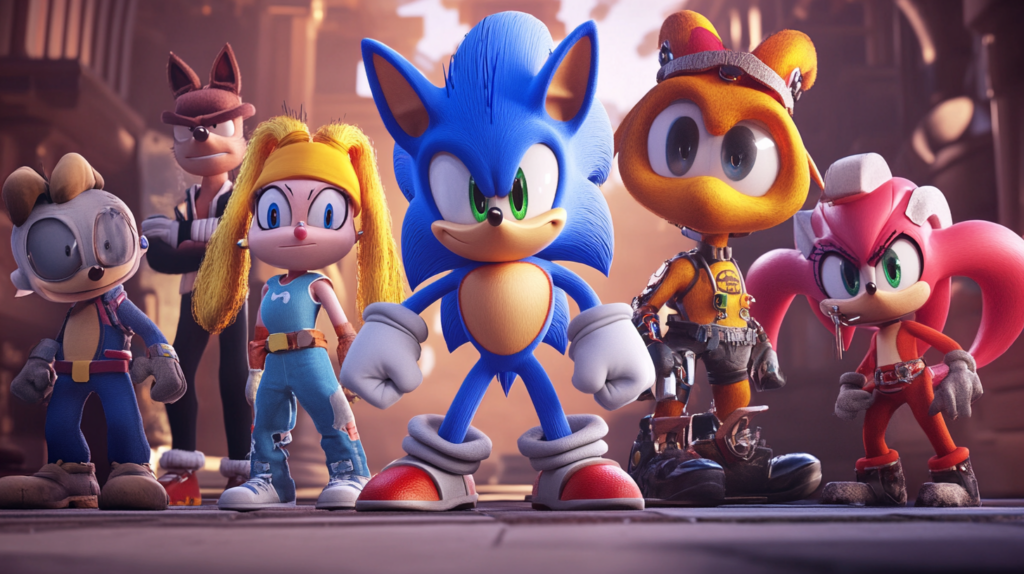The Influence of Cartoons on Gaming Culture: Cartoons and video games have always shared a close relationship, both in their visual styles and in the way they appeal to audiences. From the pixelated characters of early video games to modern-day animated cutscenes, cartoons have had a lasting influence on gaming culture. Whether it’s through the creation of iconic video game characters, the development of animated narratives, or the way animation influences gameplay mechanics, cartoons have played a pivotal role in shaping the gaming world as we know it today.
As a cartoonist, I’m fascinated by how animation and gaming culture have influenced each other. Cartoons have not only shaped the aesthetics of video games but have also influenced their storytelling, humor, and interaction with players. In this article, we’ll explore the significant impact of cartoons on gaming culture, from the early days of arcade games to the expansive, immersive worlds of modern video games.
1. The Origins: Cartoons in Early Video Games
In the early days of video gaming, the influence of cartoons was both immediate and significant. The simplicity of early video game graphics made it easier for developers to draw inspiration from animated characters and visual styles. Cartoons provided a framework for creating fun, engaging, and colorful worlds where players could immerse themselves in lighthearted and whimsical adventures.
The Birth of Iconic Video Game Characters
Many of the first major video game characters were directly inspired by cartoon designs. These characters were often designed to be easy to recognize, with exaggerated features and bold, simple shapes that made them stand out on the screen. This cartoonish aesthetic was necessary due to the technical limitations of early hardware, which could not render highly detailed graphics. Instead, characters like Mario, Sonic, and Pac-Man were designed to be colorful and simple, making them immediately recognizable to players.
Example: Super Mario Bros. (1985), created by Nintendo, introduced Mario as an instantly recognizable character with a bold red hat, mustache, and simple color scheme. His design drew directly from cartoon aesthetics, and his animations, like his jumping and running, echoed the movement and exaggerated physicality often seen in animated cartoons.
Personal Insight: As a cartoonist, I see how early game designers leveraged simple, iconic cartoon designs to create characters that were easy to animate and endear to players. These characters didn’t just appear in games—they became cultural icons in their own right, much like the beloved cartoon characters that came before them.
Cartoon-Inspired Gameplay
In addition to character design, the gameplay itself often borrowed elements from cartoons. Early video games relied on bright colors, exaggerated movement, and simple animations that were reminiscent of the fast-paced, slapstick humor typical in animated shows. These gameplay elements often mirrored the humor and excitement found in cartoons, where the rules of physics and reality were flexible.
Example: The game Donkey Kong (1981), which featured Mario as the protagonist, utilized animated cutscenes that resembled the exaggerated movements and expressions of cartoon characters. Mario’s jumping, climbing, and dodging obstacles were inspired by the dynamic, playful animation style found in cartoons.
2. The Evolution of Animation in Video Games: Cartoons Meet Cinematic Storytelling
As video game technology advanced, so did the ways in which cartoons influenced gaming culture. With the rise of more powerful consoles and advanced animation techniques, video games began to incorporate fully animated cutscenes and more complex narrative storytelling, much like the narrative-driven cartoons and animated films that preceded them.
Blending Cartoon Art with Cinematic Narratives
By the late 1990s and early 2000s, video games began to experiment with more complex, cinematic storytelling, influenced heavily by animated cartoons and films. Games like Final Fantasy VII (1997) and The Legend of Zelda: Ocarina of Time (1998) used cutscenes that featured high-quality animation and motion capture, blurring the lines between cartoons, films, and video games. These cutscenes were designed to push the narrative forward, much like animated series used visual storytelling to support their plots.
Example: Final Fantasy VII (1997) featured beautifully animated cutscenes that were cinematic in their approach, using advanced 3D animation to bring characters and environments to life in a way that resembled the intricate animation found in cartoons. The game’s emotional storytelling and visual style were heavily influenced by the aesthetics of animated films, blending the best of both mediums.
Cartoons as Inspiration for Game Worlds
Cartoons also played a significant role in shaping the design of game worlds. The vibrant, fantastical worlds found in animated shows became a model for the imaginative environments in video games. Whether it’s a magical forest, a futuristic city, or a sprawling castle, the influence of cartoons can be seen in the way these environments are designed to evoke wonder and excitement.
Example: Kingdom Hearts (2002), a game that combines characters from Disney and Square Enix, is a prime example of how cartoons have influenced game world design. The game’s worlds, based on Disney’s animated films, are visually designed to reflect the aesthetic of the cartoons, with environments and characters that fans of Disney animation instantly recognize.

3. Humor and Storytelling: Cartoon Influence on Game Narratives
Cartoons are known for their humor, wit, and clever dialogue, and these elements have made their way into video games as well. Video game developers have borrowed the comedic timing and character-driven humor of cartoons, creating game worlds that feel alive with personality and charm.
Humor and Character Personality
In games, characters often serve as the central point of humor and storytelling, much like in cartoons. The over-the-top personalities, quirks, and dynamics between characters that are common in animated series are often used in video games to engage players and add a sense of lightheartedness to the narrative. This cartoon-inspired approach to character design allows video game characters to become memorable and endearing, with humor acting as a key aspect of their appeal.
Example: The Legend of Zelda: The Wind Waker (2002) is an excellent example of how cartoons influence video game humor. With its cel-shaded art style that closely resembles animated cartoons, the game’s light-hearted tone and comedic character interactions stand out as part of its charm, much like the playful dynamics in animated series.
Parody and Satire
Many video games use parody and satire, a hallmark of cartoon humor, to comment on popular culture or make light of gaming tropes. This playful approach to storytelling adds an extra layer of entertainment for players and connects the world of gaming to the comedic sensibilities of cartoons.
Example: The Earthworm Jim series, first released in 1994, is filled with cartoon-style humor and pop culture references. The game’s absurd narrative, quirky characters, and comedic moments draw from the irreverent humor of animated cartoons, blending video game mechanics with the playful spirit of animation.
4. The Influence of Cartoon Aesthetics on Game Art Styles
Cartoons have played a pivotal role in the development of art styles in video games. The bold lines, bright colors, and exaggerated proportions typical of animated series have inspired countless video game art styles, from hand-drawn 2D sprites to 3D models that mimic cartoon designs.
Artistic Evolution: From 2D to 3D Animation
As video game graphics evolved from 2D to 3D, developers began experimenting with art styles that mimicked the aesthetic of cartoons. The success of these cartoon-inspired designs is evident in games that embrace exaggerated, playful, or fantastical designs, creating worlds and characters that feel larger than life and visually engaging.
Example: Cuphead (2017) is a standout example of a game heavily influenced by classic cartoons. Its 1930s-inspired art style, reminiscent of early Disney and Fleischer Studios animations, features fluid, hand-drawn animation and watercolor backgrounds. The game’s design pays homage to the golden age of cartoons, capturing the charm and whimsy of animation while offering challenging gameplay.
Exaggeration and Stylization in Character Design
Cartoons have also influenced the character design process in games. Exaggerated shapes, large eyes, and expressive body language are common in both animation and video game character designs. This stylization makes characters more memorable and relatable, as players connect with their exaggerated personalities and traits.
Example: Overwatch (2016) features characters that embody the bold, colorful designs of cartoons. Each character in the game has a unique, visually striking design that uses clear silhouettes, bright colors, and exaggerated features to make them easily recognizable and appealing. The game’s success can be attributed, in part, to its cartoon-inspired character designs that feel vibrant and full of life.
5. Cartoon-Inspired Music and Sound Effects in Video Games
The sound design in video games, particularly the use of music and sound effects, also draws from cartoons. The use of lively, upbeat music, whimsical sound effects, and exaggerated audio cues enhances the gaming experience, much like the soundtracks and effects in animated shows.
Playful and Energetic Soundscapes
Cartoons often use music to set the mood, from the joyful, catchy tunes of Looney Tunes to the suspenseful melodies of Batman: The Animated Series. Video game composers and sound designers draw from this energetic, playful sound palette to create a unique auditory experience that complements the cartoon-like aesthetic of their games.
Example: Banjo-Kazooie (1998) is a perfect example of how cartoon-inspired music and sound design can elevate the gaming experience. The whimsical, lighthearted soundtrack complements the game’s colorful, cartoon-inspired world, while the sound effects, like the characters’ comical grunts and interactions, bring a sense of fun and energy to the gameplay.
6. The Future: Animation and Gaming Collide
The relationship between cartoons and gaming will only grow stronger as technology continues to advance. With the rise of virtual reality (VR), augmented reality (AR), and more immersive storytelling techniques, the boundaries between cartoons and video games will continue to blur. Players may soon step into fully animated worlds that feel as though they’ve jumped right out of a cartoon, with interactions that are richer and more dynamic than ever before.
Personal Insight: As a cartoonist, I’m excited to see how the worlds of animation and gaming continue to intersect. The potential for blending the storytelling and visual techniques of cartoons with the interactive nature of gaming presents exciting opportunities for new experiences, and it will be fascinating to see how future games incorporate even more cartoon-inspired elements.
The Enduring Influence of Cartoons on Gaming Culture
The influence of cartoons on gaming culture is vast, from the visual style of characters to the humor, storytelling, and gameplay mechanics. Cartoons have provided a foundation for creating engaging, memorable video game characters, dynamic worlds, and interactive experiences that continue to evolve. As gaming technology advances, the bond between cartoons and gaming will only deepen, creating even more opportunities for creativity, innovation, and immersion.
As a cartoonist, it’s inspiring to see how my craft has intertwined with the world of gaming, shaping and enriching the experiences that millions of people enjoy. From the pixelated characters of early games to the complex narratives of today’s video games, cartoons have left an indelible mark on the gaming culture, ensuring that animation will always play a central role in how we experience digital worlds.
This post was created with our nice and easy submission form. Create your post!




